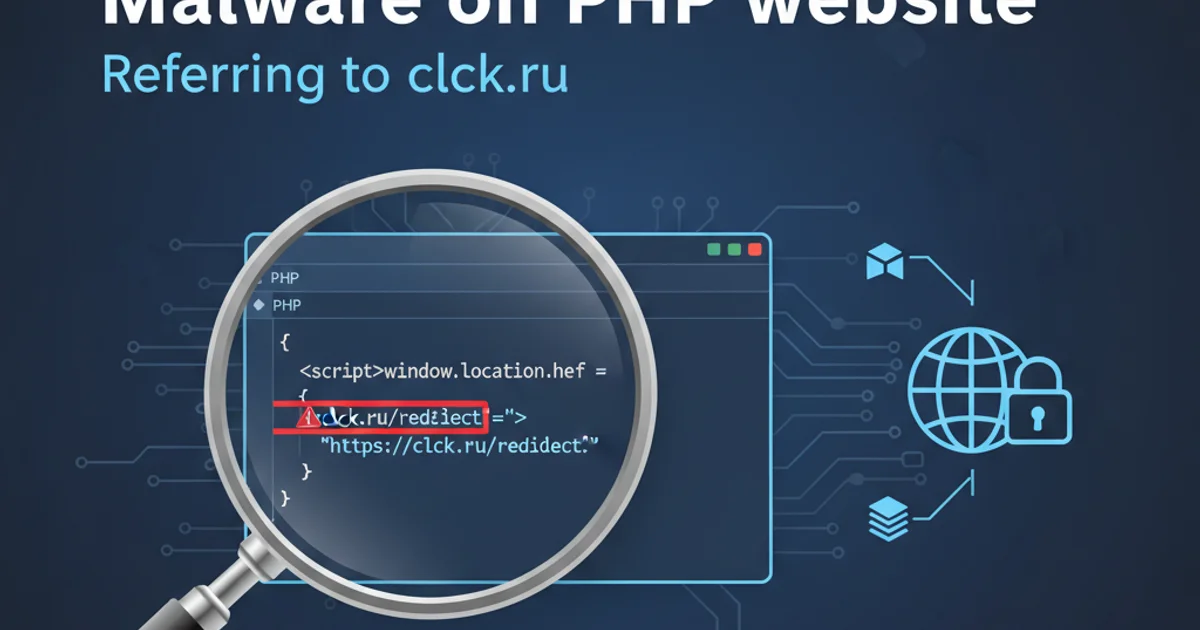Malware on PHP website, referring to clck.ru
Categories:
Detecting and Removing clck.ru Malware from PHP Websites

Learn how to identify, remove, and prevent the notorious clck.ru malware redirect from infecting your PHP-based website, safeguarding your users and SEO.
Website malware, particularly redirects to suspicious domains like clck.ru, is a common and frustrating problem for webmasters. These infections can severely damage your site's reputation, SEO rankings, and user trust. This article provides a comprehensive guide to understanding, detecting, and effectively removing clck.ru malware from PHP-based websites, along with crucial steps to prevent future infections.
Understanding the clck.ru Malware Threat
The clck.ru domain is frequently associated with malicious redirects, often leading users to spam, phishing sites, or unwanted advertisements. This type of malware typically injects malicious JavaScript or PHP code into your website files or database, which then triggers the redirect. The infection vector can vary, including compromised FTP credentials, outdated plugins/themes, weak passwords, or vulnerabilities in your server environment.
flowchart TD
A[User Accesses Website] --> B{Malicious Code Present?}
B -- Yes --> C[Redirect to clck.ru]
B -- No --> D[Legitimate Content]
C --> E[Spam/Phishing/Ads]
E --> F[Negative User Experience]
F --> G[SEO Damage & Blacklisting]
G --> H[Loss of Trust]
D --> I[Positive User Experience]Typical user flow when clck.ru malware is present
Initial Detection and Symptoms
The most obvious symptom is users being redirected to clck.ru or similar suspicious domains when trying to access your site. However, the malware can be stealthy, sometimes only redirecting specific user agents (e.g., non-admin users) or after a certain number of visits. Other signs include:
- Unexpected file modifications: New or modified files in your web root, especially
.php,.js,.htaccess. - Unusual server activity: High CPU usage, unexpected outbound connections.
- SEO spam: New, irrelevant pages appearing in search results for your domain.
- Browser warnings: Users receiving warnings about your site being malicious.
Step-by-Step Malware Removal Process
Removing clck.ru malware requires a systematic approach. Follow these steps carefully to clean your website.
1. Step 1: Isolate Your Website
The first critical step is to prevent further damage and infection. Take your website offline or redirect all traffic to a static 'maintenance mode' page. This can often be done via your hosting control panel or by temporarily modifying your .htaccess file.
2. Step 2: Change All Credentials
Assume all your passwords have been compromised. Change passwords for your hosting account, FTP, SSH, database (MySQL), CMS admin (WordPress, Joomla, etc.), and any other third-party services connected to your site.
3. Step 3: Backup Your Website (Carefully)
Create a full backup of your website files and database. While this backup will likely contain the malware, it's crucial for recovery if something goes wrong during the cleaning process. Store it offline and label it as 'potentially infected'.
4. Step 4: Scan for Malware
Use reputable server-side malware scanners (e.g., ClamAV, Maldet) or online scanners (e.g., Sucuri SiteCheck, Google Safe Browsing) to identify infected files. Pay close attention to PHP files, JavaScript files, and .htaccess files. Look for suspicious code like base64_decode, eval, gzinflate, str_rot13, or unusual header() redirects.
5. Step 5: Clean Core Files and Database
If you're using a CMS (like WordPress), replace all core files with fresh copies from the official source. For custom PHP applications, meticulously review all files for injected code. Check your database for suspicious entries in posts, pages, options, or user tables that might contain clck.ru links or malicious scripts. Look for wp_options table entries like siteurl or home being altered.
6. Step 6: Review .htaccess and JavaScript Files
Malware often hides in .htaccess files to perform redirects or in JavaScript files. Examine all .htaccess files (there might be multiple in subdirectories) for RewriteRule directives pointing to clck.ru. Scrutinize all .js files for obfuscated or unfamiliar code.
7. Step 7: Update All Software
Ensure your PHP version, CMS, themes, plugins, and any other server software are fully updated to their latest stable versions. This patches known vulnerabilities that attackers might have exploited.
8. Step 8: Re-scan and Monitor
After cleaning, run another full malware scan. Once you're confident the site is clean, bring it back online. Continuously monitor your site using security plugins, server logs, and Google Search Console for any signs of re-infection.
Example of Malicious Code Snippets
Malware often uses obfuscation to hide its true intent. Here are common patterns to look for:
PHP Obfuscated Code
.htaccess Redirect
BEGIN WordPress
MALICIOUS REDIRECT START
RewriteCond %{HTTP_USER_AGENT} (Googlebot|Bingbot|Yandex) [NC,OR] RewriteCond %{HTTP_REFERER} (google|bing|yahoo) [NC,OR] RewriteCond %{REMOTE_ADDR} !^127.0.0.1 RewriteRule ^(.*)$ http://clck.ru/malicious_link [R=301,L]
MALICIOUS REDIRECT END
JavaScript Injection
Preventing Future Infections
Prevention is always better than cure. Implement these best practices to harden your website's security:
graph TD
A[Regular Backups] --> B[Strong Passwords]
B --> C[Keep Software Updated]
C --> D[Use WAF/Firewall]
D --> E[Monitor File Integrity]
E --> F[Restrict File Permissions]
F --> G[Disable Unused Services]
G --> H[Security Scanners]
H --> AKey practices for website malware prevention
- Regular Backups: Implement automated, off-site backups. This is your last line of defense.
- Strong, Unique Passwords: Use complex passwords for all accounts (hosting, FTP, database, CMS admin) and change them regularly.
- Keep Everything Updated: Regularly update your CMS, themes, plugins, PHP version, and server software. Outdated software is the most common entry point for attackers.
- Use a Web Application Firewall (WAF): A WAF can block many common attack vectors before they reach your site.
- Monitor File Integrity: Use tools or plugins that alert you to unexpected changes in your core files.
- Restrict File Permissions: Set appropriate file and directory permissions (e.g., 644 for files, 755 for directories). Never use 777.
- Disable Unused Services: Remove or disable any unused plugins, themes, or server services.
- Regular Security Scans: Schedule periodic scans with reputable security tools.
- Secure Your Local Machine: Ensure your computer is free of malware, as compromised local machines can lead to stolen FTP credentials.